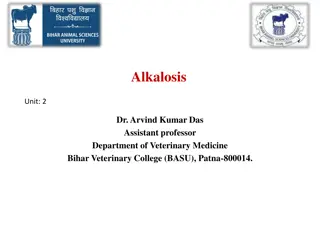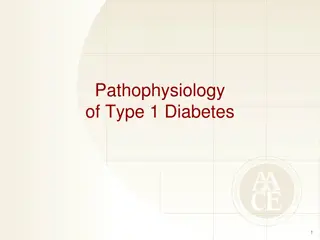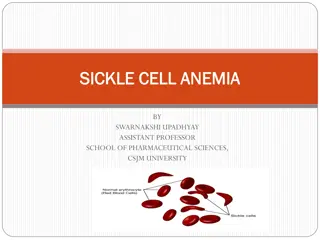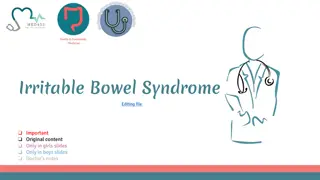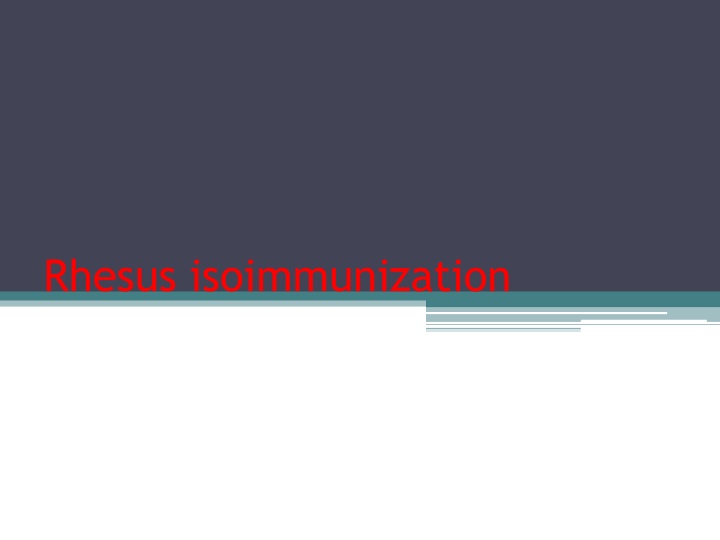
Rhesus Isoimmunization Pathophysiology
Rhesus isoimmunization occurs when Rh antibodies develop in maternal circulation, potentially harming the fetus. Learn about its incidence, etiology, immune response, pathogenesis of anemia, and more.
Download Presentation

Please find below an Image/Link to download the presentation.
The content on the website is provided AS IS for your information and personal use only. It may not be sold, licensed, or shared on other websites without obtaining consent from the author. If you encounter any issues during the download, it is possible that the publisher has removed the file from their server.
You are allowed to download the files provided on this website for personal or commercial use, subject to the condition that they are used lawfully. All files are the property of their respective owners.
The content on the website is provided AS IS for your information and personal use only. It may not be sold, licensed, or shared on other websites without obtaining consent from the author.
E N D
Presentation Transcript
presence of RH antibodies in RH ve maternal circulation or development of antibodies against antigen of other individual of the same species incidence : 45\ 1000 deliveries 10\1000 deliveries Pathophysiology Rh antigen is an antigen present on surface of RBCs confer individual specific blood group IMMUNIZATION depend on : amount of blood transfused > 0.25 ml ABO status of the fetus ABO compatible : 16% ABO incompatible : 1-2 % 15% of white 8% black 2% asian
Etiology of immunization 1. 2. 3. 4. 5. 6. 7. 8. transfusion of improperly cross matched blood feto-matermal trans placental hemorrhage(FMH OR TPH) silent abortion ectopic chorionic villus sampling amniocentesis APH external cephalic version postpartum haemorrhage
immune response when Rh positive fetal RBCs enter maternal circulation via FMH result in formation or anti-D-antibodies which pass to the fetus through placental circulation and destroy fetal RBCs to produce fetal anemia. the primary initial immune response is by IGM antibodies that s why first baby rarely affected, secondary immune response is by IGG antibodies which capable of crossing the placenta FMH in the first and second trimester are minute In the third trimester as high as 25ml Kleihauer-Betke test: Used to detect fetal RBC in maternal circulation Blood smear is prepared from the mother and treated with acid, adult HB become brown (ghost cell) while fetal RBC persist pink
Pathogenesis of anemia when maternal antibodies cross placenta, usually in the second or subsequent pregnancies that the fetus affected ,attack RH antigen on fetal RBC , - non complement mediated hemolysis occurred - End result is fetal anemia which in turn stimulate extramedullary erythropoeisis in fetal liver and spleen result in hepatospleenomegaly ( hypoproteinaemia , portal hypertension) - Profound anemia result in increase cardiac output but hypoxic heart can no longer sustain and finally result in heart failure( pericardial effusion, pleural effusion, ascitis) fetal anaemia causes hypoxia , capillary leakage result in pericardial , pleural effusion and ascitis, combination result in hydrops - To compensate for reduced oxygen supply placenta also enlarge placentomegaly
Prevention administration of RH immunoglobulin Aim : is to prevent immunization either - at birth or - antenatally 28-32weeks to take care of small FMH - any time pregnant has FMH after 12 weeks mechanism of action timing of administration 72hrs Dose 500iu =100mg before do estimate of fetal blood in maternal circulation by Kleihaur test under 50 lpf each 5 RBC equivelent = o.25ml 500iu = 4ml = 80cell in lpf Prevention of hydrops fetalis: in patient with previous history 1.o+VE gastric acid resistant capsule 2.bone marrow transplant 3.plasmaphoresis.
during delivery : hurry removal of placenta avoid unnecessary spillage of blood in peritoneal cavity amniocentesis done under USS Treatment RH negative non immunized Determine Rh status of the women ,if negative, determine husband blood group & Rh Repeat antibodies titer every 4 weeks aim is early detection of isoimmunization treat fetal anemia Prophylactic anti-D at 28 32 weeks?????? anti D to mother with V.B of unknown origin at delivery : indirect coombs test to the mother and kleihauer test give anti D within 72 hours of birth if baby Rh positive
Sensitized mother Mildly affected : when titer ICT( indirect coombs test) level less than 1 : 16 or 4iu Repeat antibodies titer every 4 weeks no invasive fetal evaluation no prophylactic anti D needed follow up by USS delivery at term moderately or severly affected if antibodies titer more tha 1:16 dilution 1- Monitor every 2 weeks 2-USS indicate feature of hydrops amount of amniotic fluid (polyhydramnias) fetal spleen and liver size
3.bowel echogenicity 4.cardiac size 5.placental thickness and size( hyperplacentosis or placentomegaly) 3- Doppler USS non invasive method of screening for fetal anemia by assessing blood flow velocity especially in middle cerebral artery MCA-PSV value is according to MOM(multiple of median) if above 1.5 MOM indicate fetal anemia repeat weekly : 4- fetal hematocrite two invasive method : 1. direct : direct invasive method of screening for fetal anemia by Cordocentesis to assess blood grouping &Rh - most effective in management of isoimmunization direct coombs test, PCV , reticulocyte count, bilirubin level
2. : indirect spectrophotometry : (old method )monitor by serial amniocentesis to detect level of bilirubin in the amniotic fluid with help of spectrophotomertry if antibodies titer increased and MCA-PSV has reached above 1.5 MOM then intrauterine transfusion should be considered or delivery - repeat intrauterine transfusion every 3 weeks - Delivery at 35 weeks or later
IUT most effective step in management of severely isoimmunization Aim is to increase haematocrit t0 35-40% two types of intrauterine transfusion : 1. Intravascular safest site is umbilical vein near cord insertion done only when fetus is hydropic or severely anemic use fresh O-Ve blood WBC removed sterilized by irradiation PCV = 90% under continuous fetal heart monitoring required 3 weekly interval 2. Intraperitoneal transfusion Used if transfusion needed in early pregnancy or vein difficult to approach
Intravenous immunoglobulin's High dose of IVIG to the mother as primary therapy Or fetal IVIG : reduce no. of blood transfusion





